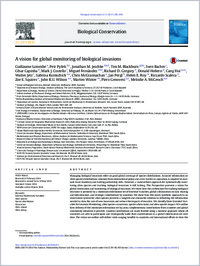A vision for global monitoring of biological invasions
- Pyšek, Petr Department of Invasion Ecology, Institute of Botany, The Czech Academy of Sciences,Průhonice, Czech Republic - Department of Ecology, Faculty of Science, Charles University in Prague, Viničná 7, Praha, Czech Republic
- Jeschke, Jonathan M. Leibniz-Institute of Freshwater Ecology and Inland Fisheries (IGB), Berlin, Germany - Freie Universität Berlin, Department of Biology, Chemistry, Pharmacy, Institute of Biology, rlin, Germany - Berlin-Brandenburg Institute of Advanced Biodiversity Research (BBIB), Berlin, Germany
- Blackburn, Tim M. Department of Genetics, Evolution & Environment, Centre for Biodiversity & Environment Research, London, UK - Institute of Zoology, LondonUK - School of Earth & Environmental Sciences and the Environment Institute, University of Adelaide, South Australia, Australia
- Bacher, Sven Unit Ecology & Evolution, Department of Biology, University of Fribourg, Switzerland
- Capinha, César CIBIO/InBIO, Universidade do Porto, Vairão, Portugal
- Costello, Mark J. Institute of Marine Science, University of Auckland, Auckland, New Zealand
- Fernández, Miguel German Centre for Integrative Biodiversity Research (iDiv) Halle-Jena-Leipzig, Leipzig, Germany - Instituto de Ecología, Universidad Mayor de San Andrés, Campus Universitario Cota, La Paz, Bolivia
- Gregory, Richard D. RSPB Centre for Conservation Science, RSPB, The Lodge, Sandy, Bedfordshire, UK
- Hobern, Donald Global Biodiversity Information Facility Secretariat, Copenhagen, Denmark
- Hui, Cang Centre for Invasion Biology, Department of Mathematical Sciences, Stellenbosch University, South Africa - Mathematical and Physical Biosciences, African Institute for Mathematical Sciences, Cape Town, South Africa - Research School of Arid Environment and Climate Change, Lanzhou University, Lanzhou 730000, China
- Jetz, Walter Department of Ecology and Evolutionary Biology, Yale University, New Haven, USA
- Kumschick, Sabrina Centre for Invasion Biology, Department of Botany and Zoology, Stellenbosch University, South Africa - Invasive Species Programme, South African National Biodiversity Institute, Kirstenbosch Research Centre, Claremont, South Africa
- McGrannachan, Chris School of Biological Sciences, Monash University, Melbourne, Australia
- Pergl, Jan Department of Invasion Ecology, Institute of Botany, The Czech Academy of Sciences,Průhonice, Czech Republic
- Roy, Helen E. Centre for Ecology & Hydrology, Benson Lane, Crowmarsh Gifford, Oxfordshire, UK
- Scalera, Riccardo IUCN SSC Invasive Species Specialist Group, Rome, Italy
- Squires, Zoe E. School of Biological Sciences, Monash University, Melbourne, Australia
- R.U.Wilson, John Centre for Invasion Biology, Department of Botany and Zoology, Stellenbosch University, South Africa - Invasive Species Programme, South African National Biodiversity Institute, Kirstenbosch Research Centre, Claremont, South Africa
- Winter, Marten German Centre for Integrative Biodiversity Research (iDiv) Halle-Jena-Leipzig, Leipzig, Germany
- Genovesi, Piero Institute for Environmental Protection and Research, Rome, Italy - IUCN SSC Invasive Species Specialist Group, Rome, Italy
- McGeoch, Melodie A. School of Biological Sciences, Monash University, Melbourne, Australia
-
01.09.2017
Published in:
- Biological Conservation. - 2017, vol. 213, no. Part B, p. 295–308
English
Managing biological invasions relies on good global coverage of species distributions. Accurate information on alien species distributions, obtained from international policy and cross-border co-operation, is required to evaluate trans-boundary and trading partnership risks. However, a standardized approach for systematically monitoring alien species and tracking biological invasions is still lacking. This Perspective presents a vision for global observation and monitoring of biological invasions. We show how the architecture for tracking biological invasions is provided by a minimum information set of Essential Variables, global collaboration on data sharing and infrastructure, and strategic contributions by countries. We show how this novel, synthetic approach to an observation system for alien species provides a tangible and attainable solution to delivering the information needed to slow the rate of new incursions and reduce the impacts of invaders. We identify three Essential Variables for Invasion Monitoring; alien species occurrence, species alien status and alien species impact. We outline how delivery of this minimum information set by joint, complementary contributions from countries and global community initiatives is possible. Country contributions are made feasible using a modular approach where all countries are able to participate and strategically build their contributions to a global information set over time. The vision we outline will deliver wide-ranging benefits to countries and international efforts to slow the rate of biological invasions and minimize their environmental impacts. These benefits will accrue over time as global coverage and information on alien species increases.
- Faculty
- Faculté des sciences et de médecine
- Department
- Département de Biologie
- Language
-
- English
- Classification
- Biological sciences
- License
- License undefined
- Identifiers
-
- RERO DOC 305604
- DOI 10.1016/j.biocon.2016.06.013
- Persistent URL
- https://folia.unifr.ch/unifr/documents/305892
Statistics
Document views: 106
File downloads:
- bac_vgm.pdf: 106
